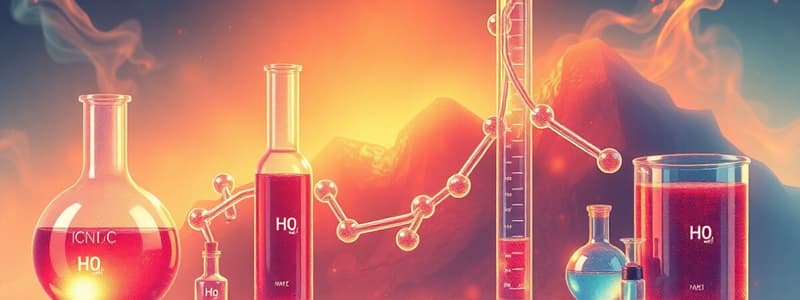Podcast
Questions and Answers
What is the relationship between pH and acidity?
What is the relationship between pH and acidity?
- pH and acidity are directly proportional.
- Increased pH indicates lower acidity. (correct)
- Decreased pH indicates lower acidity.
- pH changes do not affect acidity.
What characterizes a weak acid in terms of pKa?
What characterizes a weak acid in terms of pKa?
- Weak acids do not have a pKa.
- Weak acids fully dissociate in solution.
- Weak acids have a low pH.
- Weak acids have high pKa values. (correct)
Which of the following is a characteristic of a polyprotic acid?
Which of the following is a characteristic of a polyprotic acid?
- It is always a strong acid.
- It cannot be used in buffers.
- It can donate only one proton.
- It has one pKa for each proton it can lose. (correct)
What is the effect of a buffer's maximum buffering capacity?
What is the effect of a buffer's maximum buffering capacity?
What is the typical dissociation behavior of a strong acid?
What is the typical dissociation behavior of a strong acid?
How does an increase of one unit in pH affect hydrogen ion concentration?
How does an increase of one unit in pH affect hydrogen ion concentration?
What is the formula for the dissociation constant of weak acids (Ka)?
What is the formula for the dissociation constant of weak acids (Ka)?
Which combination of acids demonstrates monoprotic characteristics?
Which combination of acids demonstrates monoprotic characteristics?
What happens to the pH when acetate salt (CH3COONa) is added to a solution?
What happens to the pH when acetate salt (CH3COONa) is added to a solution?
What is the molarity of a solution containing 300 g of NaCl in 700 mL of solution?
What is the molarity of a solution containing 300 g of NaCl in 700 mL of solution?
Which functional group is characterized by a nitrogen atom bonded to at least one hydrogen atom?
Which functional group is characterized by a nitrogen atom bonded to at least one hydrogen atom?
What is a correct statement about a buffer solution?
What is a correct statement about a buffer solution?
Which of the following statements accurately describes acids and bases?
Which of the following statements accurately describes acids and bases?
If the concentration of H+ ions in a solution increases, what is the effect on pH?
If the concentration of H+ ions in a solution increases, what is the effect on pH?
What type of bond is primarily responsible for the interactions in a buffer system?
What type of bond is primarily responsible for the interactions in a buffer system?
What is the correct interpretation of pH = -log[H+]?
What is the correct interpretation of pH = -log[H+]?
In a neutral solution, what is the relationship between [H+] and [OH-]?
In a neutral solution, what is the relationship between [H+] and [OH-]?
Which of the following is NOT a functional group found in organic chemistry?
Which of the following is NOT a functional group found in organic chemistry?
The increase in acidity of a solution corresponds to which change in pH?
The increase in acidity of a solution corresponds to which change in pH?
What does molarity quantify?
What does molarity quantify?
If the molarity of a solution is 2 M, how many moles are there in 1 liter of solution?
If the molarity of a solution is 2 M, how many moles are there in 1 liter of solution?
How is the number of moles calculated from mass?
How is the number of moles calculated from mass?
What is Avogadro's number?
What is Avogadro's number?
What is the correct formula to calculate molarity?
What is the correct formula to calculate molarity?
What unit is used for molar mass?
What unit is used for molar mass?
What mass of NaCl is present in 0.3 kg for calculating molarity?
What mass of NaCl is present in 0.3 kg for calculating molarity?
If 0.3 kg of NaCl is dissolved in 700 mL of water, how many liters does this represent for calculations?
If 0.3 kg of NaCl is dissolved in 700 mL of water, how many liters does this represent for calculations?
What is the equivalent of one Dalton in terms of molar mass?
What is the equivalent of one Dalton in terms of molar mass?
In terms of concentration, what does the term 'molar concentration' refer to?
In terms of concentration, what does the term 'molar concentration' refer to?
What formula represents the calculation of molarity?
What formula represents the calculation of molarity?
If the mass of a substance is 7.3 kg and its molar mass is 300 g/mol, how many moles does it contain?
If the mass of a substance is 7.3 kg and its molar mass is 300 g/mol, how many moles does it contain?
What is the unit of volume used in the molarity formula?
What is the unit of volume used in the molarity formula?
To find the number of moles using mass and molar mass, which formula is used?
To find the number of moles using mass and molar mass, which formula is used?
If a solution has a molarity of 1 M and a volume of 2 L, how many moles of solute are present?
If a solution has a molarity of 1 M and a volume of 2 L, how many moles of solute are present?
What is the result of dividing mass by molar mass?
What is the result of dividing mass by molar mass?
Using a molar mass of 300 g/mol, how many grams are in 5 moles of a substance?
Using a molar mass of 300 g/mol, how many grams are in 5 moles of a substance?
A solution is prepared with 4 moles of solute in 2 L of solution. What is the molarity of the solution?
A solution is prepared with 4 moles of solute in 2 L of solution. What is the molarity of the solution?
Which of the following could mislead one regarding the definition of molarity?
Which of the following could mislead one regarding the definition of molarity?
What does a higher molarity indicate about a solution?
What does a higher molarity indicate about a solution?
Flashcards
Molarity
Molarity
A measure of concentration, expressed as the number of moles of solute per liter of solution.
Solution volume
Solution volume
The total volume of the solution, measured in liters.
Number of moles
Number of moles
The amount of a substance contained in a given mass, expressed in moles.
Molar mass
Molar mass
Signup and view all the flashcards
Solute
Solute
Signup and view all the flashcards
Solvent
Solvent
Signup and view all the flashcards
Concentration
Concentration
Signup and view all the flashcards
Periodic table
Periodic table
Signup and view all the flashcards
Mole
Mole
Signup and view all the flashcards
Solution
Solution
Signup and view all the flashcards
Molarity
Molarity
Signup and view all the flashcards
Molar Concentration
Molar Concentration
Signup and view all the flashcards
Moles
Moles
Signup and view all the flashcards
Molar Mass
Molar Mass
Signup and view all the flashcards
Avogadro's Number
Avogadro's Number
Signup and view all the flashcards
Solute
Solute
Signup and view all the flashcards
Solution
Solution
Signup and view all the flashcards
Mole Calculation
Mole Calculation
Signup and view all the flashcards
Unit of Molarity
Unit of Molarity
Signup and view all the flashcards
Formula for Moles
Formula for Moles
Signup and view all the flashcards
Molarity Definition
Molarity Definition
Signup and view all the flashcards
Acid Definition
Acid Definition
Signup and view all the flashcards
Base Definition
Base Definition
Signup and view all the flashcards
pH Definition
pH Definition
Signup and view all the flashcards
pH Scale
pH Scale
Signup and view all the flashcards
Buffer Definition
Buffer Definition
Signup and view all the flashcards
Hydroxyl Group
Hydroxyl Group
Signup and view all the flashcards
Carbonyl Group
Carbonyl Group
Signup and view all the flashcards
Carboxyl Group
Carboxyl Group
Signup and view all the flashcards
Functional Groups
Functional Groups
Signup and view all the flashcards
Ammonia Buffer
Ammonia Buffer
Signup and view all the flashcards
Buffer Solution
Buffer Solution
Signup and view all the flashcards
Weak Acid Dissociation Constant (Ka)
Weak Acid Dissociation Constant (Ka)
Signup and view all the flashcards
pKa
pKa
Signup and view all the flashcards
pKa Relationship to Strength
pKa Relationship to Strength
Signup and view all the flashcards
Monoprotic Acid
Monoprotic Acid
Signup and view all the flashcards
Polyprotic Acid
Polyprotic Acid
Signup and view all the flashcards
Buffering Capacity
Buffering Capacity
Signup and view all the flashcards
pH and [H+]
pH and [H+]
Signup and view all the flashcards
Buffer Range
Buffer Range
Signup and view all the flashcards
Study Notes
Molarity
- Molarity is a concentration measure.
- It's the number of moles of solute per liter of solution.
- Expressed as M (molar) or mol/L.
- Formula: Molarity (M) = moles of solute / liters of solution
- Moles of solute = mass of solute (g) / molar mass (g/mol)
Calculating Molarity
- Example: Find the molarity of 0.3 kg NaCl dissolved in 700 mL water.
- Mass of NaCl = 300 g
- Molar mass of NaCl = 58.44 g/mol
- Volume of solution = 0.7 L
- Moles of NaCl = 300 g / 58.44 g/mol = 5.1 moles
- Molarity = 5.1 moles / 0.7 L = 7.33 M (or 7.33 mol/L)
Types of Chemical Bonds
- Ionic Bond: Bond formed by transferring electrons.
- Covalent Bond: Bond formed by sharing electrons.
- Polar Covalent Bond: Covalent bond where electrons are shared unevenly.
- Non-Polar Covalent Bond: Covalent bond where electrons are shared equally.
- Hydrogen Bond: Weak bond between a hydrogen atom and an electronegative atom.
- Metallic Bond: Bond formed by the attraction between metal ions and delocalized electrons.
Functional Groups
- Hydroxyl group (-OH): Found in alcohols.
- Carbonyl group (C=O): Found in ketones and aldehydes.
- Carboxyl group (-COOH): Found in carboxylic acids.
- Amino group (-NH2): Found in amines.
- Sulfhydryl group (-SH): Found in thiols.
- Phosphate group (-OPO32-): Found in organic phosphates.
- Methyl group (-CH3): Modifies the function of molecules.
Acids and Bases
- Acid: A proton donor.
- Base: A proton acceptor.
- pH: A measure of the concentration of H+ ions in a solution.
- pH = -log[H+]
- Higher H+ concentration, lower pH (more acidic)
- Buffer: A solution that resists changes in pH when small amounts of acid or base are added.
- Buffers are composed of a weak acid/base and its conjugate.
- Ka: Dissociation constant of weak acids.
- pKa: The negative logarithm of Ka. Indicates the acidity of a weak acid. Weak acids have a pKa value.
Studying That Suits You
Use AI to generate personalized quizzes and flashcards to suit your learning preferences.



